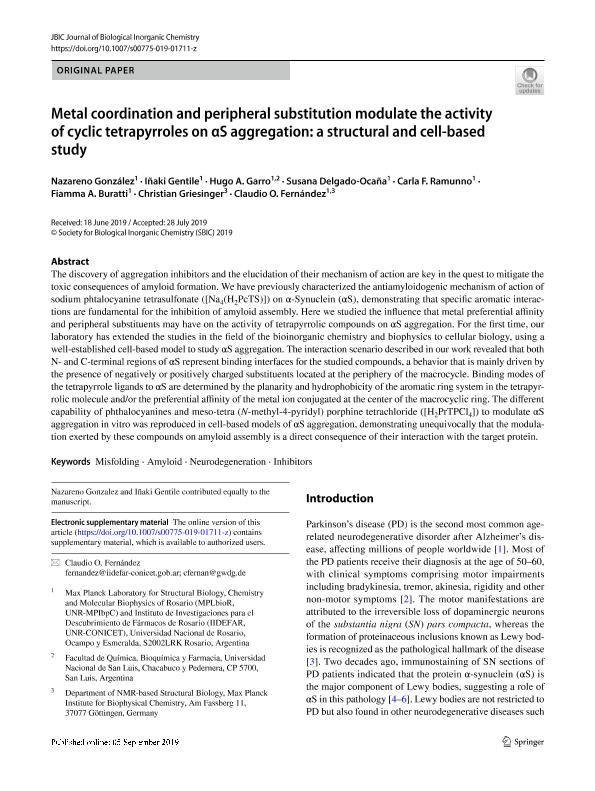Artículo
Metal coordination and peripheral substitution modulate the activity of cyclic tetrapyrroles on αS aggregation: a structural and cell-based study
González, Nazareno ; Gentile, Iñaki; Garro, Hugo Alejandro
; Gentile, Iñaki; Garro, Hugo Alejandro ; Delgado Ocaña, Susana
; Delgado Ocaña, Susana ; Ramunno, Carla F.; Buratti, Fiamma Ayelen
; Ramunno, Carla F.; Buratti, Fiamma Ayelen ; Griesinger, Christian; Fernandez, Claudio Oscar
; Griesinger, Christian; Fernandez, Claudio Oscar
 ; Gentile, Iñaki; Garro, Hugo Alejandro
; Gentile, Iñaki; Garro, Hugo Alejandro ; Delgado Ocaña, Susana
; Delgado Ocaña, Susana ; Ramunno, Carla F.; Buratti, Fiamma Ayelen
; Ramunno, Carla F.; Buratti, Fiamma Ayelen ; Griesinger, Christian; Fernandez, Claudio Oscar
; Griesinger, Christian; Fernandez, Claudio Oscar
Fecha de publicación:
12/2019
Editorial:
Springer
Revista:
Journal of Biological Inorganic Chemistry
ISSN:
0949-8257
Idioma:
Inglés
Tipo de recurso:
Artículo publicado
Clasificación temática:
Resumen
The discovery of aggregation inhibitors and the elucidation of their mechanism of action are key in the quest to mitigate the toxic consequences of amyloid formation. We have previously characterized the antiamyloidogenic mechanism of action of sodium phtalocyanine tetrasulfonate ([Na4(H2PcTS)]) on α-Synuclein (αS), demonstrating that specific aromatic interactions are fundamental for the inhibition of amyloid assembly. Here we studied the influence that metal preferential affinity and peripheral substituents may have on the activity of tetrapyrrolic compounds on αS aggregation. For the first time, our laboratory has extended the studies in the field of the bioinorganic chemistry and biophysics to cellular biology, using a well-established cell-based model to study αS aggregation. The interaction scenario described in our work revealed that both N- and C-terminal regions of αS represent binding interfaces for the studied compounds, a behavior that is mainly driven by the presence of negatively or positively charged substituents located at the periphery of the macrocycle. Binding modes of the tetrapyrrole ligands to αS are determined by the planarity and hydrophobicity of the aromatic ring system in the tetrapyrrolic molecule and/or the preferential affinity of the metal ion conjugated at the center of the macrocyclic ring. The different capability of phthalocyanines and meso-tetra (N-methyl-4-pyridyl) porphine tetrachloride ([H2PrTPCl4]) to modulate αS aggregation in vitro was reproduced in cell-based models of αS aggregation, demonstrating unequivocally that the modulation exerted by these compounds on amyloid assembly is a direct consequence of their interaction with the target protein.
Palabras clave:
AMYLOID
,
INHIBITORS
,
MISFOLDING
,
NEURODEGENERATION
Archivos asociados
Licencia
Identificadores
Colecciones
Articulos (IIDEFAR)
Articulos de INSTITUTO DE INVESTIGACIONES PARA EL DESCUBRIMIENTO DE FARMACOS DE ROSARIO
Articulos de INSTITUTO DE INVESTIGACIONES PARA EL DESCUBRIMIENTO DE FARMACOS DE ROSARIO
Citación
González, Nazareno; Gentile, Iñaki; Garro, Hugo Alejandro; Delgado Ocaña, Susana; Ramunno, Carla F.; et al.; Metal coordination and peripheral substitution modulate the activity of cyclic tetrapyrroles on αS aggregation: a structural and cell-based study; Springer; Journal of Biological Inorganic Chemistry; 24; 8; 12-2019; 1269-1278
Compartir
Altmétricas



